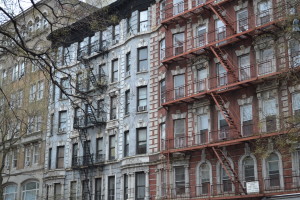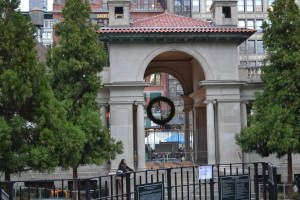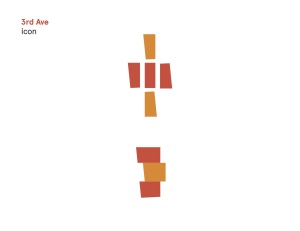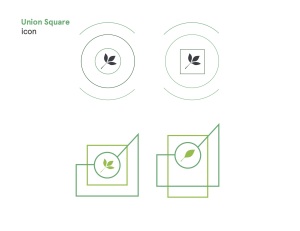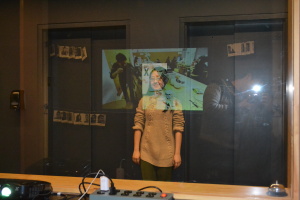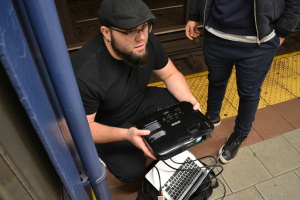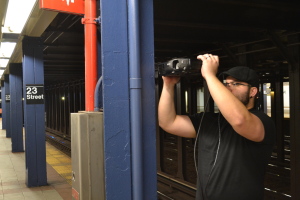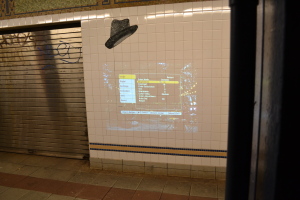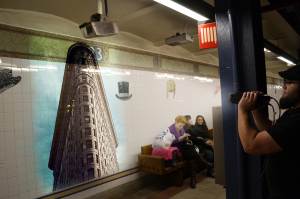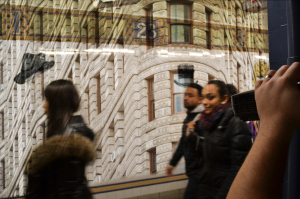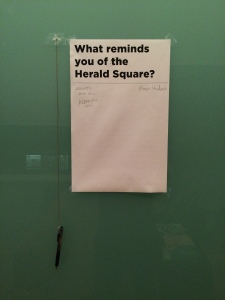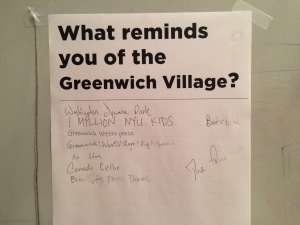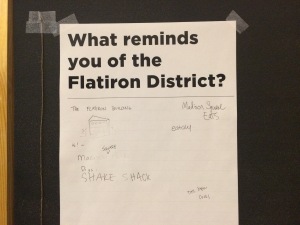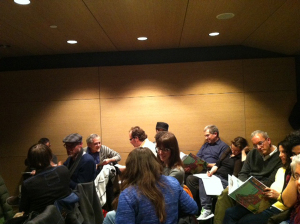Sarah, Mini, Trent, Sam W.
Understand Levi Stadium
Levi stadium is introducing a comprehensive wireless experience, with a stadium that can handle massive bandwidth and an app…”that will enhance your gameday experience with features including mobile tickets and parking passes, mobile ordering of food and beverages, wayfinding to navigate around the building, and a “game center” for high-definition video replays.”Initial thoughts on the game and the 49ers
“It is a turf war”
Making symbolic hay here, but the 49ers used to play in Golden Gate Park on the corner of Haight and Ashbury Street. Those days were really cosmic. There aren’t even parking lots around the stadium. Steve Spurrier, their quarterback for 9 years in the mid 60s and 70s, used to park in front of some hippies’ crash pad before games. Characters, he said, “you couldn’t figure out with a slide rule.”
In 1970 the team moved to Candlestick from Kezar Park. It’s interesting to note the 49ers have never had their own dedicated stadium until now.
That the stadium has moved from Golden Gate Park to the south side of the city, down to Santa Clara is something to pay attention to. The SAP tower has a view out the back to look out over Silicon Valley.
- Existing Product in the Market
Ticketing Service – EventBrite, Ticketmaster, Fandango, ParkWhiz
Food Ordering Service – Seamless, Chipotle online order, GrubHub
Location and Way finding – Google Map (shows traffic and direction), Find Friends
Video streaming – ESPN online, YouTube
- User Groups by Level of Engagement Across a Timeline
Occasional or Special Occasion visitors – Friends, tourist, visitors, families who visits the stadium 1-3 times a year. Possibly not familiar with the sports or the culture
Seasonal Ticket Holders – Families or Individuals who are enthusiastic about the sports and the team and understand the culture very well. Come to the game to socialize and meet people
Seasonal Ticket Holder with more VIP Status – Families, corporations, individuals and friends who have more resources, who expect luxurious treatment and comfort and in the VIP boxes.
- Expert Interview and Findings
Our team spoke with Ran Henry, football aficionado, journalist, and author of the upcoming book, “Spurrier: How The Ball Coach Taught the South to Play Football.”
Expert Interview
Levi’s stadium is introducing a comprehensive wireless experience, with a stadium that can handle massive bandwidth and an app…”that will enhance your gameday experience with features including mobile tickets and parking passes, mobile ordering of food and beverages, wayfinding to navigate around the building, and a “game center” for high-definition video replays.”
Our team spoke with Ran Henry, football aficionado, journalist, and author of the upcoming book, “Spurrier: How The Ball Coach Taught the South to Play Football.”
Top Level Insights
- “It’s a huge difference in my experience, if you have tickets or if you’re out scalping. It must be stated immediately that it’s a huge differential. If you have plans to tail gait or not is also a huge variable.”
- “Territoriality is a huge concept here—who gets to park closer to the stadium? There’s a pecking order among fans.”
- How do people relate to being a 49er? “I guess the whole thing with them was the gold rush. If you haven’t seen A View to a Kill lately, you should.”
- Through cheering and volume, fans can feel as if they have an affect on players’ performances. It’s quite possible they actually do.
- The extreme athleticism of the players can affect how fans treat the spectacle of watching—there are more crashes, and harder hits than almost any other sport or level of football (i.e. college or high school level).
- There’s something going on every minute of the event—specifically when the game is expected to make a lot of money from TV ad sales. Whenever there’s a commercial break, there’s a pause in the action.
- Football is a hard game to really follow. There are 11 different battles going on during every play, so there’s a lot of value in having replays available.
- A lot of fans currently use their phones to keep up with scores of other games happening at the same time, particularly games that affect their team in the future.
- Fans definitely travel to games, but the locals are still a strong presence. Many 49ers fans reside in southern San Francisco—a far different neighborhood from say, the Mission, or the Valley.
- Fans in stadiums are looking for simple upgrades—better seats to sit on, nicer bathrooms, cheap beer.
- A big difference between watching the game on TV and being in a stadium is the level of knowledge and charisma of the announcers. TV announcers are usually ex-athletes who have a window into the inner workings of the game.
- Advances in cameras and video editing have greatly contributed to the sport feeling more and more like a video game. Exploring how that coincides with the rise in video game culture might be an interesting angle.
- A bad user experience at a football game is losing.
- There’s a great degree of raw emotion that happens among fans at football games. This is potentially an area to investigate.
List of User Activities
- Arriving at stadium by public transit
- Arriving at stadium by car
- Tailgaiting activities
- Cooking food
- Playing sports
- People watching
- Eating food
- Drinking alcohol
- Keeping tabs on other games
- Entering the stadium
- Finding seats
- Watching game
- Watching stadium video screen
- Replays
- Score from other games
- Entertainment
- Talking to other people present
- Regulars, or season ticket holders
- Ushers
- Friends
- Other people in the stadium
- Cheering
- Jeering
- Eating
- Food from home
- Food purchased at stadium
- Drinking
- Drinks from home
- Drinks purchased at stadium
- Shopping
- Using the bathroom
- Finding a bathroom
- Waiting in line
Initial thoughts on the game and the 49ers
“It is a turf war”
Making symbolic hay here, but the 49ers used to play in Golden Gate Park on the corner of Haight and Ashbury Street. Those days were really cosmic. There aren’t even parking lots around the stadium. Steve Spurrier, their quarterback for 9 years in the mid 60s and 70s, used to park in front of some hippies’ crash pad before games. Characters, he said, “you couldn’t figure out with a slide rule.”
In 1970 the team moved to Candlestick from Kezar Park. It’s interesting to note the 49ers have never had their own dedicated stadium until now.
That the stadium has moved from Golden Gate Park to the south side of the city, down to Santa Clara is something to pay attention to. The SAP tower has a view out the back to look out over Silicon Valley.
(Side note: Jerry Walker is the curator of the new SF’s 49er museum at Levi, and we can get in contact with him if need be.)
Full Expert Interview
Can you take me through a typical game day? List as many details as you can.
It’s a huge difference in my experience, if you have tickets or if you’re out scalping. It must be stated immediately that it’s a huge differential. If you have plans to tail gait or not is also a huge variable.
It’s just unbelievable what people bring to the area around the stadium—kitchen utensils, cooking gear.
Territoriality is a huge concept here—who gets to park closer to the stadium? There’s a pecking order among fans.
The ticket scalping experience is all about getting close to the action, and tailgating experiences are the same.
Think about the hotel situation—the tiniest room in a holiday inn will rent for $400-$500 on game day.
I don’t know how those tailgating spots work out—-but there about to spend about 14.5million dollars to tear up the concrete and install grass around the stadium at the University in South Carolina.
There was one couple that was really upset about being moved back from the stadium 70 yards or so in the new configuration, after years of tailgating.
Once the team starts to warm up, the more hardcore fans head into the stadium. The starting quarterback might be based on how the warmups happen. That’s about 20 minutes before kick-off.
It’s a full day—people show up with their slow cooker. There’s a lot of football actually being played…from ball passing to full games. Families are there with kids.
And the jerseys…people are in team jerseys. They’re wearing shirts by the players they identify with. They’re taking on the qualities of the mascots.
There’s something soulless about representing cities.
How do people relate to being a 49er?
I guess the whole thing with them was the gold rush. If you haven’t seen A View to a Kill lately, you should.
The incredible power of your rival is that they are the mirror image of you. The chomp and the chop…UF and FSU. But back to those rituals…everyone knows the chants and the cheers…it’s the group assimilation idea. Spurrier is always saying that football is the ultimate team sport.
Take the Florida fans—they are so loud when the other team has the ball…humming out Ommmmmmmmm. And it’s quite loud. The crowd can get so loud, the player’s helmets will rattle. But when the home team has the ball, its pin quiet.
The idea is that the fan in the stands can indeed influence the outcome of the game. Like in Louisiana, they’re just loud there.
I think NFL fans are a little bit more bloodthirsty. There’s what, 2,000 jobs in the NFL in the full-time squads? The guys that make it are incredible athletes. The hits are harder, and it causes your average spectator to celebrate a major collision between two human beings. You can’t downplay that. All those weekday frustrations find an outlet. That’s a fact.
All NFL stadiums sell alcohol, and I’ve seen some serious dust-offs. If you wear a jersey of a visiting team, you’re going to get some serious talk back.
What about during the game?
To elucidate the idea of fans—there’s always some schmuck who will try to kick a field goal for $25,000, and they always fail. Fans get to cheer, and jeer. That’s become a game day staple. And the subwoofer—it’s mind-bending how low and subsonic that can get. There’s gotta to be something going on every minute. For example, South Carolina put in a giant
In Candlestick, they had to change the wind patterns with screens. The projector was pretty antiquated. You’d think it would be the opposite.
Of course, now at Levi you get to watch on wifi. But you’re at the game??
What’s the value?
The replays have a different camera…but really, it’s savoring those great moments. Football is a hard game to watch. Most people might just know the quarterback got sacked, but there’s so much set-up going on.
What about looking at a phone versus a massive video screen?
You can’t under-appreciate the way the NFL induces communities to put huge resources into these stadiums and the big carrot there is the Superbowl. How much is Levi paid for by the Valley versus the 49ers?
Spectacle of the video screen?
I’ve never spent a game looking at my phone, so I don’t have an emotional connection.
I snuck into the Superbowl in 1989 and the half-time trick was to turn the seat cushions over in synchrony. The idea of spectacle can’t be leaned on too heavily. This whole idea that people will be looking at their phones versus a video board would be radical.
I do notice the people I’m around though, and one thing about phones is that everyone has to know about scores, even from other games…particularly the ones that affect your team. Phones are a conduit to knowing and in that I’ve seen a lot of people on their phones. The idea that phones being used to keep up with the game right in front of you, in Levi Stadium, that would be a new thing.
What’s your understanding of how the fans fit into the tech vision
I don’t know that they do. The locals at Candlestick were the arbiters of legacy, but I don’t where they fit into this new stadium. The locals are going to affect the demographics of the people in the stadium.
At Candlestick it was not hard to find people wearing old jerseys. Where are the people who watched when the games were at Kezar?
And the hardcore fans who would travel? Their tech experience is lower. I wonder what the pricing structure is different from Candlestick.
I didn’t talk to anyone at Candlestick who would pay $500 for a sushi meal at Levi. Not one. It’s a different breed of person.
How vociferous will these new Silicon Valley folks be versus your hardcore fan?
How much is this a TV experience? How does the stadium look on TV?
What would people want in their new stadium?
I just don’t think that for the average football fans that amenities are that big of a thing. Like think about aluminum slates versus having chair backs. Something as simple as that would work for the hardcore fans.
What about food?
I think to junk food out is their goal…to go back to that idea of the weekend release. It’s very primal—nachos, big slices of cheese on your hamburger.
I sense very strongly that Levi stadium would be the antithesis of that.
There’s some sociological import to food selection. Certainly. The traditional stadium fare couldn’t be more elemental.
Tell me a bit about Candlestick Park. Was there anything about it that stuck out to you? Or seemed unusual?
Yeah, those video screens were tiny. Again, the whole idea of bringing the TV experience to the stadium. And the bleachers were designed to be reconfigured for baseball. The stadium didn’t fully look like a football stadium. Stadium design matters in influencing the crowds ability to be right on top of the action, and to have an impact on the game. At Candlestick it was the other side of the field, the visiting team’s side, that the baseball configuration matters. Fans were more removed from the game.
What would you expect to be able to experience in the new Levi’s Stadium, based on your experience in Candlestick?
Any fan would say, first and foremost, just a great seat. The closer you are to the game the fewer distractions there are, but the further up you get the more distractions you need, because the players look like ants down there. Configuration matters there.
How is watching a game at an arena different than watching with a bunch of friends at home? What are the key activities?
The commentators are typically ex-athletes, and it’s an entirely different experience when they’re not there. Another aspect of the arena experience is that people will wear headsets to get that auditory experience. They can’t watch the game without it. Maybe that’s where a phone could come in. The announcer is nothing like a TV commentary.
I feel when I watch with friends that I haven’t really watched a game. There’s less focus. That’s a definite. Friends are distracting and football is a hard game to watch. There’s 11 different battles going on in each play. There’s a camaraderie but you don’t get as much of the game.
What about groups of people at the arena?
Season ticket holders are the same people week in and week out in the same section. To me it’s probably a huge social thing, but they’re less focused. The number of season tickets at Levi would be something to look into, and how they apportioned those tickets would be a big deal. These are your real fans.
They’re rowdier. They bring a lot to the stadium experience. They’ve had those same seats for years and decades.
What do you during downtime between plays while you’re at an arena?
There barely is. The advent of the hurry-up offense is a big factor here. The number of plays has gone up over time. There’s always something going on. Great care and choreography is taken to not have a second of downtime. At the very least you’re going to hear a snippet of a song.
What about while you’re watching with friends at home?
That’s the commercials. At the stadium you feel that. That the game gets dragged on because at home they’re seeing more commercials. In the bigger games there’s more downtime because there’s more commercials being sold and you can definitely feel that.
The commercials definitely do take you out of the game. There has to be at least three and a half to four minutes of commercials per break.
What get the fans in an arena most excited?
I would say some kind of highlight clips that perhaps recount the first half. Other than that it would be something on the field. Highlight clips generally have slow-motion. “Did you see that hit!” They have amazing production values considering it just happened. And never forget, there’s that camera on the field now, and it feels like a video game. It can see what the quarterback sees and it can swoop around very quickly.
I would be very interested in how the advent of video games has affected multiple aspects of the game, even the training aspect.
Do you have any stories about a bad time you had during a football game?
Losing. The air goes out of the building. Neurologically and biologically, a man’s testosterone goes up and down 20-40% based on whether the team wins or loses. That’s a big part of it. People screaming? For four hours? And in a pro football game, the teams are so damn good that teams lose all the time. And there’s no comparison between winning and losing in a pro stadium. And home field advantage is going to be an interesting thing to watch at Levi.
People are talking about the small details. There’s vicarious experience and everyone’s an armchair commentator or quarterback. There’s a great manly code being expressed.
If you could collect any kind of information on fans at a game, what would you collect?
This is something I’ve thought carefully about. It’s just that rare, incredibly unfiltered random outbursts. Where the truth cannot be contained. What we all look for in literature—that raw emotion and how people express that.
In 2008 a fan stood up at a Carolina game and yelled, “Jesus himself couldn’t coach this football team.” The game in some way empowers people to have a Howard Beale moment. “I’m mad as hell and I’m just not going to take it anymore.”
Here’s an example of one fan’s thought about the University of South Carolina losing on a Saturday night to Missouri:
“I’d been fooling myself the last three or four years. I thought I’d finally matured as a fan and had moved beyond the ugly days of screaming out loud, huffing and puffing, pacing, fuming, cursing and generally behaving like a serial killer during Gamecock games. After all, I’m 41 years old now. It’s been two decades since I was a student at USC. I patted myself on the back after the Texas A&M debacle for watching quietly and saying things like “It’s a long season, let’s just let it play out,” perhaps forgetting that I’ve always handled blowouts better than nail-biters. There’s also the fact that we just haven’t lost many games over the last few years. I simply haven’t had too many opportunities to implode. Well, we reached Full Implosion Mode on Saturday night. Let’s just say that there was a lot of yelling, enough that our neighbors may be making plans right now to have me evicted. When our last-ditch, final fourth-down pass fell incomplete, I ripped off my shirt and hurled it against the wall, overcome with such fury that I felt like one of those werewolves in the “Twilight” movies (I’m sorry to say that this actually did happen). All the while, my girlfriend glared at me with one of those “I’m strongly contemplating packing your stuff and putting it out on the sidewalk” looks. You never want to be on the receiving end of those. All in all, I had the worst night of anybody, even worse than the offense. “
Findings
- People want to access the game easily and closely as possible
- Other findings?
Creation Myth
Sports connect us in a myriad of fashions, playing, entertaining, teaching, and communicating. More than three-fifths of U.S adults claim to have a relationship to sport activities*. Sports empowers our lives.
What about the space the sport is in, could that place provide direct access and a more meaningful experience to the qualities that sports gives us?
With Levi’s Stadium, we are going to do just that. This stadium will remove barriers that get in the way of why you’re here. But here’s the real kicker, it’s all under your control. Getting your tickets, parking passes, ordering food, stadium’s map, and never missing a moment on the field will be at your command with just a tap. You do all this and more under our new app for your mobile device.
You are now connected to everything around you and using it to your needs. Giving you the ability to focus on what you love most, the game.
*2010 USADA commissioned a survey of 9,000 Americans

